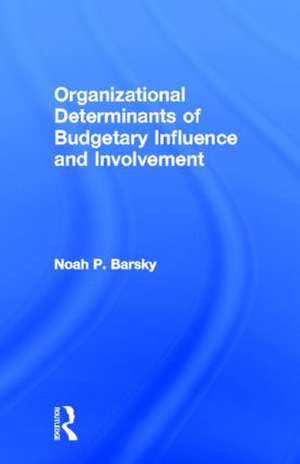Organizational Determinants of Budgetary Influence and Involvement
Autor Noah P. Barskyen Limba Engleză Hardback – oct 1999
The findings indicate that influence, not involvement, is the key to empowerment in the budgeting process. This research suggests that researchers and practitioners should be aware of an organization's social structure when examining a participative budgeting process. The difference between formal designs and actual influence is indicative of a "rhetoric-reality gap" which can impair the effectiveness of management control systems.
| Toate formatele și edițiile | Preț | Express |
|---|---|---|
| Paperback (1) | 216.07 lei 6-8 săpt. | |
| Taylor & Francis – 15 iul 2016 | 216.07 lei 6-8 săpt. | |
| Hardback (1) | 595.89 lei 6-8 săpt. | |
| Taylor & Francis – oct 1999 | 595.89 lei 6-8 săpt. |
Preț: 595.89 lei
Preț vechi: 941.87 lei
-37% Nou
Puncte Express: 894
Preț estimativ în valută:
114.06€ • 123.94$ • 95.87£
114.06€ • 123.94$ • 95.87£
Carte tipărită la comandă
Livrare economică 21 aprilie-05 mai
Preluare comenzi: 021 569.72.76
Specificații
ISBN-13: 9780815335504
ISBN-10: 0815335504
Pagini: 118
Dimensiuni: 138 x 216 x 13 mm
Greutate: 0.38 kg
Ediția:1
Editura: Taylor & Francis
Colecția Routledge
Locul publicării:Oxford, United Kingdom
ISBN-10: 0815335504
Pagini: 118
Dimensiuni: 138 x 216 x 13 mm
Greutate: 0.38 kg
Ediția:1
Editura: Taylor & Francis
Colecția Routledge
Locul publicării:Oxford, United Kingdom
Cuprins
Chapter 1 Introduction; Chapter 2 Literature Review and Development of Hypotheses; Chapter 3 Research Methods; Chapter 4 Data Analysis; Chapter 5 Management Communication and Control Systems Diagnostic Questionnaire; Chapter 6 Conclusions;
Descriere
Drawing on network theory from the organizational sociology literature, this book examines issues related to which organizational factors determine how employees influence the budgeting process. Data were collected from managers who participate in the budgeting process at a major apparel manufacturer. Social network analysis was employed to measure how the structure of the network of managers affects the budgeting process. The results show that budgetary influence is structurally determined and resides with managers holding central positions in the organizational network. Thus, while formal procedures determine which employees are involved in budgeting activities, only centrally positioned managers actually influence budgetary outcomes.
The findings indicate that influence, not involvement, is the key to empowerment in the budgeting process. This research suggests that researchers and practitioners should be aware of an organization's social structure when examining a participative budgeting process. The difference between formal designs and actual influence is indicative of a "rhetoric-reality gap" which can impair the effectiveness of management control systems.
The findings indicate that influence, not involvement, is the key to empowerment in the budgeting process. This research suggests that researchers and practitioners should be aware of an organization's social structure when examining a participative budgeting process. The difference between formal designs and actual influence is indicative of a "rhetoric-reality gap" which can impair the effectiveness of management control systems.


















